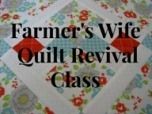Have you ever written directions to make a quilt block from scratch? No? I have, and it takes a lot of time and work. My friend Karen has written more than her fair share as well. Did we both make miscalculations? You bet'cha! Sometimes they are biggies, and sometimes they are as small as a 16th of an inch. Now you are saying, so, its only a 16th of an inch, that's 3 or 4 threads, no biggie and that is where you are wrong.

Here is what a 16th of an inch looks like, not big at all, 3 maybe 4 threads at most!

Now here is what a 1/16th of an inch looks like. Ok, so you say, I can work that out with the feed dogs of my machine...
Maybe, but your finished center will look like this...... Wrinkled and painful, points that don't match, just sad.

This block is supposed to measure 6 1/2. Not 7+.. not a happy block!
So what went so honorably wrong?
The little 16th of an inch measurements on all of the little squares that are around the middle.
Believe it or not, 1/16th of an inch from two sides made the block go together with no problems.
So instead of being 1 5/8, they are 1 9/16, that is 1/16th less (or the trimmings you see above)
Here is how the math works.
When you sew the two small squares together (the orange and brown on my block) they should measure the same size as the center block, which is 2 5/8". What Karen did, was to jot down the small square size as 1 5/8... simple typo and when you are typing as many numbers and fractions as she does, well, it goes without saying that a booboo or two is going to happen, it's not rocket science, it's a quilt!
So the math looks like this: All of the small squares should measure 1 9/16", even the ones for the center corners so they match the side squares. 1 9/16" + 1 9/16" = 3 1/8". Now remove 1/2" for the seam allowances (1/4" on each square) and you have 2 5/8", the exact size of the center square!
This block does require that you sew a PERFECT 1/4 inch seam, not a SCANT, if you sew a scant, you are adding back in 1/32" to each seam and nothing will fit and you will be right back where we started from!
Yes, a 16th of an inch makes all the difference in the world!
Karen has made the corrections in her lessons, republished them and if you have purchased lesson 8 prior to 9/10/14 you will need to get the updated copy. If you need help in finding the update, send Karen a message at chezstitches@gmail.com, and she will get you a corrected copy right away.
If you have not checked our her blog, Laugh Yourself into Stitches please do so, she has freebies, wonderful patterns and always answers her e-mails with a smile :)
Happy Farming!







































